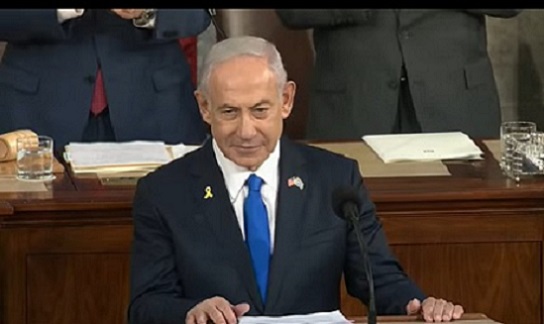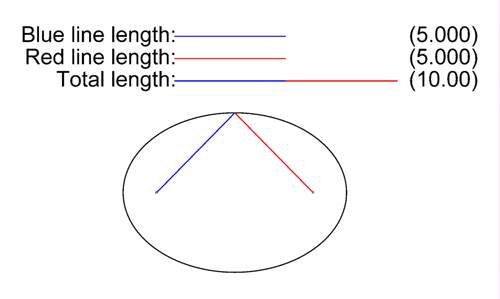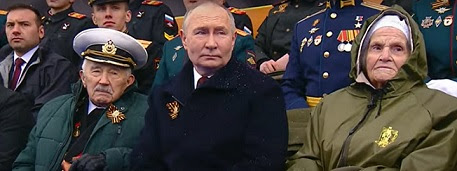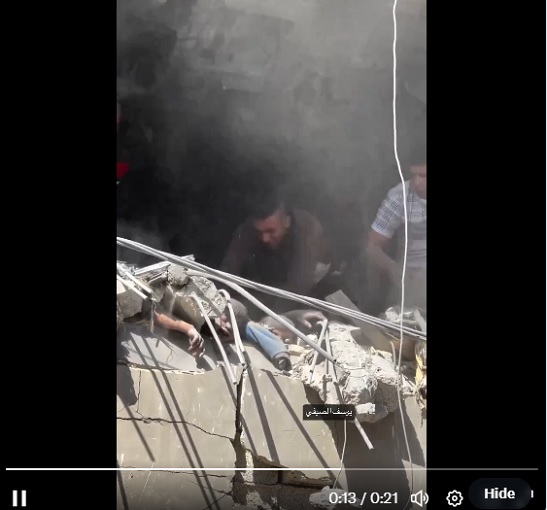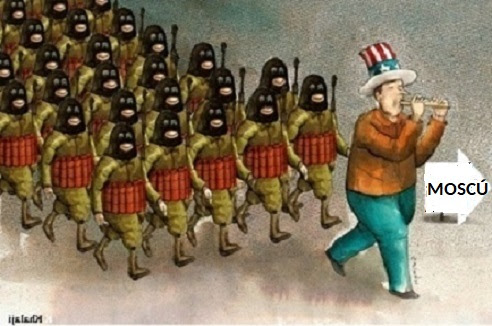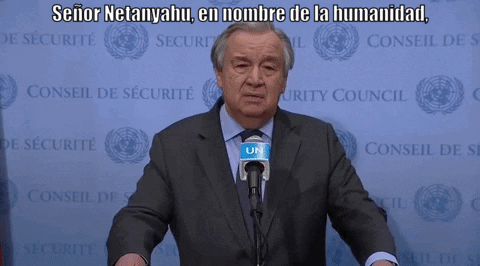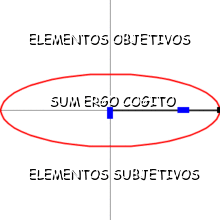The World is at a dangerous Crossroads.
The Western military alliance is in an advanced state of readiness. And so is Russia.
Russia is heralded as the “Aggressor”. US-NATO military confrontation with Russia is contemplated.
Enabling legislation in the US Senate under “The Russian Aggression Prevention Act” (RAPA) has “set the US on a path towards direct military conflict with Russia in Ukraine.”
Any US-Russian war is likely to quickly escalate into a nuclear war, since neither the US nor Russia would be willing to admit defeat, both have many thousands of nuclear weapons ready for instant use, and both rely upon Counterforce military doctrine that tasks their military, in the event of war, to preemptively destroy the nuclear forces of the enemy. (See Steven Starr, Global Research, August 22, 2014)The Russian Aggression Prevention Act (RAPA) is the culmination of more than twenty years of US-NATO war preparations, which consist in the military encirclement of both Russia and China:
From the moment the Soviet Union collapsed in 1991, the United States has relentlessly pursued a strategy of encircling Russia, just as it has with other perceived enemies like China and Iran. It has brought 12 countries in central Europe, all of them formerly allied with Moscow, into the NATO alliance. US military power is now directly on Russia’s borders. (Steven Kinzer, Boston Globe, March 3, 2014, emphasis added)
NATO’s top commander in Europe General Philip Breedlove (right) (AFP Photo / John Thys)
On July 24, in consultation with the Pentagon, NATO’s Europe commander General Philip Breedlove called for “stockpiling a base in Poland with enough weapons, ammunition and other supplies to support a rapid deployment of thousands of troops against Russia”.(RT, July 24, 2014). According to General Breedlove, NATO needs “pre-positioned supplies, pre-positioned capabilities and a basing area ready to rapidly accept follow-on forces”:
“He plans to recommend placing supplies — weapons, ammunition and ration packs — at the headquarters to enable a sudden influx of thousands of Nato troops” (Times, August 22, 2014, emphasis added)Breedlove’s “Blitzkrieg scenario” is to be presented at NATO’s summit in Wales in early September, according to The London Times. It is a “copy and paste” text broadly consistent with the Russian Aggression Prevention Act (RAPA) which directs President Obama to:
“(1) implement a plan for increasing U.S. and NATO support for the armed forces of Poland, Estonia, Lithuania, and Latvia, and other NATO member-states; andMore generally, a scenario of military escalation prevails with both sides involved in extensive war games.
(2) direct the U.S. Permanent Representative to NATO to seek consideration for permanently basing NATO forces in such countries.” (S.2277 — 113th Congress (2013-2014))
In turn, the structure of US sponsored military alliances plays a crucial role in war planning. We are dealing with a formidable military force involving a global alliance of 28 NATO member states. In turn, the US as well as NATO have established beyond the “Atlantic Region” a network of bilateral military alliances with “partner” countries directed against Russia, China, Iran and North Korea.
Major US-NATO Naval Exercises
War preparations are invariably accompanied and preceded by major military exercises.
US-NATO multi-warfare naval exercises are to be conducted off the Florida coastline under operation FLEETEX, with the participation of the US, Canada, Germany and Turkey.
The underlying premise of these war games is “global warfare”. All four NATO member states are adjacent to strategic sea corridors, which are contiguous to Russian maritime areas, respectively the Bering Sea and straits (US), the Arctic Ocean (Canada), the North Sea (Germany) and the Black Sea (Turkey).
The Florida war games are predicated on multi-country integration and coordination of naval operations directed against an unnamed enemy:
FLEETEX are multi-warfare naval exercises designed to promote force integration and test multiple war fighting skill sets. Ships from the U.S., Canadian, German and Turkish navies will participate in the exercises. This port visit and FLEETEX are part of a series of training exercises in which SNMG2 will participate during its deployment to the Western Atlantic. This is the first time in several years that a NATO task force has conducted transatlantic operations in North America. These events offer multiple opportunities for training at the highest levels of maritime operations.FLEETEX will feature anti-air, anti-submarine, live fire and ship handling scenarios designed to provide high-end warfare training and valuable experience through integrated task group training. SNMG2, CSG8 and Canadian forces will train together as a force to learn how to work as a cohesive unit in response to a variety of threat scenarios.
SNMG2 ships currently deployed to North America include the U.S. flagship, USS LEYTE GULF (CG 55), the German ship FGS NIEDERSACHSEN (F 208), and the Turkish ship TCG KEMALREIS (F 247).SNMG2 is permanently available to NATO to perform a wide range of tasks, from real world operations to exercise participation. Composition of the force varies as allied nations contribute assets on a rotational basis. SNMG2 will be led by a U.S. Navy admiral and flagship until June 2015. (For further details see North Atlantic Treaty Organization, Allied Maritime Command HQ MARCOM Public Affairs Office, http://www.aco.nato.int/snmg2-is-in-florida-to-prepare-for-fleetex.aspx, August 18, 2014, emphasis added)
….
During the port visit, SNMG2 will coordinate with representatives from the Canadian navy and Carrier Strike Group 8 (CSG8) to prepare for the exercises…
“Any opportunity we have to train with multiple NATO navies simultaneously is extremely valuable,” said Rear Adm. Brad Williamson, Commander SNMG2. “This period will allow us to build integration and teamwork, and I’m excited to train with and share experiences between Allied shipmates.”
Black Sea War Games
It is worth noting that FLEETEX is one among several US-NATO naval war games directed against an unnamed enemy. In July, NATO conducted naval exercises in the Black sea, in an area contiguous to Russia’s maritime borders.
NATO’s “Breeze” formally hosted by Bulgaria took place from July 4 to July 13, with the participation of naval vessels from Greece, Italy, Romania, Turkey, the U.K. and the U.S.
The underlying scenario was the “”destruction of enemy ships in the sea and organization of air defense of naval groups and coastal infrastructure.”
The exercises were “aimed at improving the tactical compatibility and collaboration among naval forces of the alliance’s member states…” (See Atlantic Council , see also Russia, U.S. ships sail in competing Black Sea exercises, July 7, Navy Times 2014)
Ironically, NATO’s July Black Sea games started on exactly the same day as those of the “unnamed enemy”[Russia], involving its Crimea Black sea fleet of some 20 war ships and aircraft:
Russia has made it clear they don’t welcome NATO’s presence in the Black Sea. Russia’s navy let it be known that it is following the exercises with reconnaissance aircraft and surveillance ships.Deployment of Ground Forces in Eastern Europe
“The aviation of the Black Sea Fleet is paying special attention to the missile cruiser USS Vella Gulf which, though not formally the flagship of the ‘Breeze’ exercises, effectively is leading them,” a Russian naval source told NTV. (Ibid)
Since 2006, the US has been building up its weapons arsenal in Poland on Russia’s Western border (Kalingrad). The deployment of US forces in Poland was initiated in July 2010 (within 40 miles from the border), with a view to training Polish forces in the use of US made Patriot missiles. (Stars and Stripes, 23 July 2010).
In recent developments, the Pentagon announced in early August the deployment of US troops and National Guard forces to Ukraine as part of a military training operation. US-NATO is also planning further deployments of ground forces (as described by NATO General Breedlove) in Poland, Latvia, Estonia and Lithuania as well as in Georgia and Azerbaijan on Russia’s southern border.
These deployments which are envisaged in the draft text of the “Russian Aggression Prevention Act” (RAPA) (S.2277 — 113th Congress (2013-2014)) are also part of a NATO “defensive” strategy in the case of a “Russian invasion”:
Russia’s annexation of Crimea and the conflict in eastern Ukraine have alarmed Latvia, Estonia and Lithuania – like Ukraine, former Soviet republics with Russian-speaking minorities.Germany’s Angela Merkel, during a short visit to Latvia on Monday, pledged NATO would defend the Baltic states, although it would not send permanent combat troops.
NATO’s 28 leaders are expected to discuss plans to reassure Poland and the Baltics at a summit in Wales on Sept. 4-5.
“Any country, including the Baltic states, also Poland, have to strengthen their infrastructure … so they can host additional troops for training and crisis situations,” Latvia’s Defense Minister Raimonds Vejonis told Reuters.
In Latvia’s case that would mean investments in Adazi base for ground troops, Lielvarde air base and Liepaja naval base, he said, adding he hoped NATO would contribute to the spending.
Latvia and Lithuania spend respectively just 0.9 and 0.8 percent of GDP on defense but have pledged to meet the alliance’s target of 2.0 percent by 2020.
“There is no direct military threat at the moment, but we have to develop our armed forces, we have to create infrastructure, we have to be ready to host representatives of NATO countries if there suddenly is a military aggression,” the minister said. Baltics and Poland need more military infrastructure. (Reuters, August 22, 2014)Deployments on Russia’s South Border
with Azerbaijan and Georgia
Deployment on Russia’s Southern border is to be coordinated under a three country agreement signed on August 22, 2014 by Turkey, Georgia and Azerbaijan:
Following the trilateral meeting of Azerbaijani, Turkish and Georgian defense ministers, Tbilisi announced that the three countries are interested in working out a plan to strengthen the defense capability.Russia and Obama’s “Pivot to Asia”
“The representatives of the governments of these three countries start to think about working out a plan to strengthen the defense capability,” Alasania said, adding that this is in the interests of Europe and NATO.“Because, this transit route [Baku-Tbilisi-Kars] is used to transport the alliance’s cargo to Afghanistan,” he said.
Alasania also noted that these actions are not directed against anyone. (See Azeri News, August 22, 2014, emphasis added)
In the Far-east, Russia’s borders are also threatened by Obama’s “Pivot to Asia”.
The “Pivot to Asia” from a military standpoint consists in extending US military deployments in the Asia-Pacific as well as harnessing the participation of Washington’s allies in the region, including Japan, South Korea and Australia. These countries have signed bilateral military cooperation agreements with Washington. As US allies, they are slated to be involved in Pentagon war plans directed against Russia, China and North Korea:
Japan and South Korea are also both part of a grand U.S. military project involving the global stationing of missile systems and rapid military forces, as envisioned during the Reagan Administration. (Mahdi Darius Nazemroaya, Global Military Alliance: Encircling Russia and China, Global Research, October 5, 2007)
US-Australia Military Agreement
On August 12, the US and Australia signed a military agreement allowing for the deployment of US troops in Australia. This agreement is part of Obama’s Pivot to Asia:
The U.S. and Australia signed an agreement Tuesday [August 12] that will allow the two countries’ militaries to train and work better together as U.S. Marines and airmen deploy in and out of the country.Ironically, coinciding with the announcement of the US-Australia agreement (August 12), Moscow announced that it would be conducting naval exercises in the Kuril Islands of the Pacific Ocean (which are claimed by Japan):
“This long-term agreement will broaden and deepen our alliance’s contributions to regional security,” U.S. Defense Secretary Chuck Hagel said Tuesday. He described the U.S.-Australia alliance as the “bedrock” for stability in the Asia-Pacific region.
Since 2011, the number of Marines there has grown from about 250 to more than 1,100 now. Australian Defense Minister David Johnston said the northern territory looks forward to the Marine presence growing to the 2,500 limit.
“Exercises began involving military units in the region, which have been deployed to the Kuril Islands,” Colonel Alexander Gordeyev, a spokesman for Russia’s Eastern Military District, told news agency Interfax. (Moscow Times, August 12, 2014)The Dangers of a Third World War
While this renewed East-West confrontation has mistakenly been labelled a “New Cold War”, none of the safeguards of The Cold War era prevail. International diplomacy has collapsed. Russia has been excluded from the Group of Eight (G-8), which has reverted to the G-7 (Group of Seven Nations). There is no “Cold War East-West dialogue” between competing superpowers geared towards avoiding military confrontation. In turn, the United Nations Security Council has become a de facto mouthpiece of the U.S. State Department.
US-NATO will not, however, be able to win a conventional war against Russia, with the danger that military confrontation will lead to a nuclear war.
In the post-Cold war era, however, nuclear weapons are no longer considered as a “weapon of last resort” under the Cold War doctrine of “Mutual Assured Destruction” (MAD). Quite the opposite; nuclear weapons are heralded by the Pentagon as “harmless to the surrounding civilian population because the explosion is underground”. In 2002, the U.S. Senate gave the green light for the use of nuclear weapons in the conventional war theater. Nukes are part of the “military toolbox” to be used alongside conventional weapons.
When war becomes peace, the world is turned upside down. In a bitter irony, nukes are now upheld by Washington as “instruments of peace”.
In addition to nuclear weapons, the use of chemical weapons is also envisaged. Methods of non-conventional warfare are also contemplated by US-NATO including financial warfare, trade sanctions, covert ops, cyberwarfare, geoengineering and environmental modification technologies (ENMOD). But Russia also has extensive capabilities in these areas.
Western leaders in High office are Involved in a Criminal Undertaking which Threatens the Future of Humanity
The timeline towards war with Russia has been set. The Wales NATO venue on September 4-5, 2014 is of crucial importance.
What we are dealing with is a World War III Scenario, which is the object of the Wales NATO Summit, hosted by Britain’s Prime Minister David Cameron. The agenda of this meeting has already been set by Washington, NATO and the British government. It requires, according to PM David Cameron in a letter addressed to heads of State and heads of government of NATO member states ahead of the Summit that:
“Leaders [of NATO countries] must review NATO’s long term relationship with Russia at the summit in response to Russia’s illegal actions in Ukraine. And the PM wants to use the summit to agree how NATO will sustain a robust presence in Eastern Europe in the coming months to provide reassurance to allies there, building on work already underway in NATO.” (See PM writes to NATO leaders ahead of NATO Summit Wales 2014)It is essential to undermine the “military timeline”, namely to:
2) In addition to the 28 NATO member states, represented by their respective heads of State and heads of government, NATO “partner” countries will also be represented. In all, the governments of 60 countries will be in attendance. It is therefore crucial to initiate a vast Worldwide antiwar campaign in all 60 countries to stall the NATO Summit meeting in Wales.*
4) initiate a broad anti-war debate and protest movement throughout the US and NATO member states.
5) undermine the legitimacy of the US-NATO-Israel military agenda through counter-propaganda directed against mainstream media coverage.
World public opinion must be made aware of these impending war plans. !
Spread the word far and wide. !
::::::::::::::::::::::::::::::::::::::
Vamos a completer las características de éste "Inmencionado Enemigo" con otro 'mencionado' nombre, aparte de Rusia, Asia. Para ello vamos a tomar parte de éste artículo
By Bruce Gagnon
Global Research, August 25, 2014
titulado: "The Pentagon’s Strategy for World Domination: Full Spectrum Dominance, from Asia to Africa"
Using new space technologies to coordinate and direct modern warfare also enables the military industrial complex to reap massive profits as it constructs the architecture for what the aerospace industry claims will be the “largest industrial project” in Earth history.
TARGET: ASIA
The deployment of Navy Aegis destroyers in the Asian-Pacific region, with MD interceptors on-board, ostensibly to protect against North Korean missile launches, gives the US greater ability to launch preemptive first-strike attacks on China.
The US now has 30 ground-based MD interceptors deployed in South Korea. Many peace activists there maintain that the ultimate target of these systems is not North Korea, but China and Russia.
Europe’s leaders are complicit in Full Spectrum Dominance.
The current US military expansion underway in Hawaii, South Korea, Japan, Guam, Okinawa, Taiwan, Australia, Philippines and other Pacific nations is indeed a key strategy in this offensive “pivot” to control China.
An additional US goal is to have the “host” countries make significant contributions toward helping the Pentagon cover the cost of this massively expensive escalation.
For many years the US Space Command has been annually war gaming a first-strike attack on China. Set in the year 2017 the Pentagon first launches the military space plan that flies through the heavens and unleashes a devastating first-strike attack on China’s nuclear forces – part of the new “Global Strike” program.
In the war game China then attempts to launch a retaliatory strike with its tens of nuclear missiles capable of hitting the west coast of the continental US. But US “missile defense” systems, currently deployed in Japan, South Korea, Australia, Guam and Taiwan, help take out China’s disabled nuclear response.
Obama’s former Secretary of Defense Robert Gates’ comments were quite revealing in 2009 when he said, “We’re converting more Navy Aegis ships to have ballistic missile defense that would help against China.”
Missile defense, sold to the public as a purely defensive system, is really designed by the Pentagon to be the shield after the first-strike sword has lunged into the heart of a particular nation’s nuclear arsenal.
Living in Bath, Maine, I have a special perspective on this US-China military competition. In my town, the Navy builds the Aegis destroyers that are outfitted with MD systems. Congressional leaders from my state maintain that more Pentagon funds for Aegis shipbuilding are needed to “contain” China.
Renowned author Noam Chomsky says "US foreign and military policy is now all about controlling most of the world’s oil supply as a “lever of world domination.” One way to keep Europe, China, India and other emerging markets dependent on the US and in sync with its policies is to maintain control of the fossil fuel supply they’re reliant on.
Even as the US economy is collapsing, the Pentagon appears to be saying, whoever controls the keys to the world’s economic engine still remains in charge.
China, for example, imports up to 80% of its oil on ships through the Yellow Sea. If any competitor nation was able to militarily control that transit route and choke off China’s oil supply, its economy could be held hostage.
One is able to see how the Pentagon will use the South Korean Navy base on Jeju Island, now being constructed despite a seven-year determined non-violent campaign opposing the base, to support the potential coastal blockade of China
CONCLUSIONS
For many years Russia and China have introduced resolutions at the UN calling for negotiations on a new treaty that would ban weapons in space.
Since the mid-‘80s every UN member nation has supported the “Prevention of an Arms Race in Outer Space” (PAROS) resolution, with the exception of the US, Israel, and Micronesia.
This was true during the Clinton presidency as well as during the reign of George W. Bush and now under Obama as well.
A full-blown arms race between the US, Russia and China will be a disaster for the world and would make life on Earth less secure. At the very time that global resources are urgently needed to deal with the coming harsh realities of climate change and growing poverty, we can hardly afford to see more money wasted on the further militarization of space and greater superpower conflict.
The Pentagon actually has the largest carbon boot print on the planet. The US insisted that the Pentagon be excluded from the Kyoto climate change protocols and refused to sign the agreements unless the Pentagon was exempted.
As the US undertakes arming the world to the benefit of corporate globalization our local communities have become addicted to military spending. As we oppose the aggressive US military empire overseas we must also talk about the job issue back at home. Calling for conversion of the military industrial complex, demanding that our industrial base be transformed to create a renewable energy infrastructure for the 21st century, helps us come into coalition with weapons production workers who must now support the killing machine if they hope to feed their families (....)"
Bruce K. Gagnon is the Coordinator of the Global Network Against Weapons & Nuclear Power in Space and is author of the book Come Together Right Now: Organizing Stories from a Fading Empire. He lives in Bath, Maine. www.space4peace.org
:::::::::::::::::::::::::
Este ha sido un 'post' un tanto largo, pero hemos querido dar una idea de ese "Inmencionado Enemigo" tras el cual va The Full Spectrum Dominance del Imperialismo, que, por obvias razones, no es un partidista esquema mental del carnaval izquierdista ni una inquebrantable fijación pulsional anclada contra nadie ni contra nada...tendríamos suerte si fuese asi. Pero son los hechos.
Y hemos querido enfatizarlos en el fundamental aspecto militar, la localización, desarrollo y logística de las legiones imperiales en las estrategias de su dinámica geo-política, porque sin éste lúminico cuadro no podríamos entender quíen es quíen y que es lo que realmente está ocurriendo, de lo contrario todo se quedaría en retórica, subjetivismos y abstraccismos.
Y se me ocurre terminar mencionando el cerco que ya tiene trazado el imperialismo, y sus fieles socios, alrededor de Rusia. Como mencionaba Chossudovsky:
"Since 2006, the US has been building up its weapons arsenal in Poland on Russia’s Western border (Kalingrad). The deployment of US forces in Poland was initiated in July 2010 (within 40 miles from the border)".
Imaginémosnos ahora que pasaría si a 40 millas de San Diego, California, en Tijuana, México, Rusia hubiése hecho lo mismo que el imperio en Kalingrad, Polonia. La cuestion, la imaginacion, se deja incontestada porque todos sabemos muy bien lo que pasaría. Y ésto nos da una idea bastante clara de lo que aqui se ha tratado.


















































































































































































